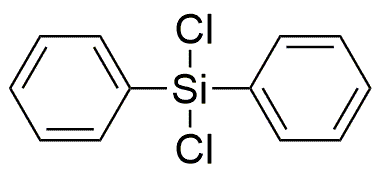Dichlorodiphenylsilane is widely utilized in research focused on:
- Silicone Production: This compound serves as a key intermediate in the synthesis of silicone polymers, which are used in a variety of applications including sealants, adhesives, and lubricants.
- Surface Modification: It is employed to modify surfaces of materials to enhance their hydrophobicity, making it valuable in industries like textiles and coatings where water resistance is crucial.
- Organic Synthesis: Researchers use it as a reagent in organic synthesis, particularly in the formation of siloxane bonds, which are essential in creating complex chemical structures.
- Electronics Manufacturing: In the electronics industry, it is used in the production of semiconductor materials, contributing to the development of advanced electronic devices.
- Research and Development: It plays a significant role in R&D for developing new materials and chemicals, particularly in fields like nanotechnology and polymer science.
General Information
Properties
Safety and Regulations
Applications
Dichlorodiphenylsilane is widely utilized in research focused on:
- Silicone Production: This compound serves as a key intermediate in the synthesis of silicone polymers, which are used in a variety of applications including sealants, adhesives, and lubricants.
- Surface Modification: It is employed to modify surfaces of materials to enhance their hydrophobicity, making it valuable in industries like textiles and coatings where water resistance is crucial.
- Organic Synthesis: Researchers use it as a reagent in organic synthesis, particularly in the formation of siloxane bonds, which are essential in creating complex chemical structures.
- Electronics Manufacturing: In the electronics industry, it is used in the production of semiconductor materials, contributing to the development of advanced electronic devices.
- Research and Development: It plays a significant role in R&D for developing new materials and chemicals, particularly in fields like nanotechnology and polymer science.
Documents
Safety Data Sheets (SDS)
The SDS provides comprehensive safety information on handling, storage, and disposal of the product.
Product Specification (PS)
The PS provides a comprehensive breakdown of the product’s properties, including chemical composition, physical state, purity, and storage requirements. It also details acceptable quality ranges and the product's intended applications.
Certificates of Analysis (COA)
Search for Certificates of Analysis (COA) by entering the products Lot Number. Lot and Batch Numbers can be found on a product’s label following the words ‘Lot’ or ‘Batch’.
Número de catálogo
Número de lote/lote
Certificates Of Origin (COO)
This COO confirms the country where the product was manufactured, and also details the materials and components used in it and whether it is derived from natural, synthetic, or other specific sources. This certificate may be required for customs, trade, and regulatory compliance.
Número de catálogo
Número de lote/lote
Safety Data Sheets (SDS)
The SDS provides comprehensive safety information on handling, storage, and disposal of the product.
DownloadProduct Specification (PS)
The PS provides a comprehensive breakdown of the product’s properties, including chemical composition, physical state, purity, and storage requirements. It also details acceptable quality ranges and the product's intended applications.
DownloadCertificates of Analysis (COA)
Search for Certificates of Analysis (COA) by entering the products Lot Number. Lot and Batch Numbers can be found on a product’s label following the words ‘Lot’ or ‘Batch’.
Número de catálogo
Número de lote/lote
Certificates Of Origin (COO)
This COO confirms the country where the product was manufactured, and also details the materials and components used in it and whether it is derived from natural, synthetic, or other specific sources. This certificate may be required for customs, trade, and regulatory compliance.


